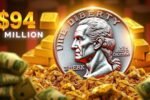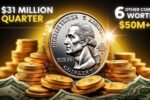Introduction
If you have that 1976 Bicentennial Quarter in your pocket you may want to look at more closely. Most of these coins are just worth 25 cents but few selected types have sold for millions of dollars at auctions. The single Bicentennial Quarter is thought to be worth almost $10 million; others have sold for more than $150,000. Maybe you or someone you know possess one of these special quarters. Let’s dive into the details.
The Rare Bicentennial Quarter Worth Nearly $10 Million
The Bicentennial Quarter that has the highest price is a coin that bears proof that it was minted on a silver planchet with a very rare defect. This rare piece of currency has the double die obverse, off-center striking, and a proof-like deep cameo finish making this coin unparallel.
What Makes This Quarter So Valuable?
- Silver Composition: Some of the Bicentennial Quarters struck bore copper-nickel composition while others were mistakenly made on a 40% silver planchet.
- Double Die Obverse (DDO): This means that the image on this coin was being engraved with double strikes and that shows in the lettering of its surface and its profile.
- Off-Center Strike: This was a strike through the middle where the design on the surface of the new coin seems off centered.
- Deep Cameo Finish: Some of the available proof coins are silver and some of the proof coins have mirrored background and the design is frosted.
Estimated Value: Nearly $10 Million!
This quarter is one of the most rare for the United States and if you ever find another cent with the same appearance you could be a millionaire!
6 More Bicentennial Quarters Worth $150,000+
While not all Bicentennial Quarters are millions, some have been auctioned off for six figures. Here are six more you should look out for:
1976-S Silver Proof Bicentennial Quarter ($175,000+)

How to Identify It:
- If they can find a wear, there is a cupronickel “S” mintmark positioned under the President’s neck.
- The coin itself should be composed of 40% silver (Ranking: About 5.75 grams).
- Original proof has the background copied to the mirror; the design of the proof version is frosted.
1976 Bicentennial Quarter – Double Die Obverse ($165,000+)
How to Identify It:
- Look for doubling in the words “LIBERTY ” and “ IN GOD WE TRUST”.
- For minor doubling effects, try locating them using a magnifying glass.
1976 Bicentennial Quarter Struck on a Nickel Planchet ($155,000+)
How to Identify It:
- This quarter was produced as if it were a five cent (nickel) and therefore it is smaller and weighs less.
- Again, this one has a less brightness and comes with only 5 grams instead of 5.67 grams.
[also_read id=”1417″]
1976 Bicentennial Quarter With Missing Clad Layer ($150,000+)

How to Identify It:
- This is circulating quarters: some of them had no the outer layer with nickel while others have a dull copper center.
- The metal will be a sort of red-brown instead of the shiny silver appearance.
1976 Bicentennial Quarter With Off-Center Strike ($150,000+)
How to Identify It:
- The design must be moved at least 50 percent off the center while maintaining the full date on the layout.
- Oddities which are very far from the original design are always considered more precious than those which only slightly deviate from the original design of the coin.
1976 Bicentennial Quarter on an Experimental Planchet ($150,000+)
How to Identify It:
- Some of the test coins were made on experimental test materials, they thus had different weight.
- If a quarter appears to be of a different color, weight or texture in a particular quarter then it could well be one of the above variants.
[also_read id=”1385″]
How to Check If You Have a Rare Bicentennial Quarter
If you think you’ve found a valuable Bicentennial Quarter, follow these steps:
- Use a Magnifying Glass: Search for doubled images, off centered strike or missing mint marks.
- Check the Weight: Standard quarters have an average weight of 5.67 grams and may not have a similar weight when they are made of silver or if they include an error.
- Look for the Mint Mark: Again, quarters from San Francisco (“S”) are generally more desirable.
- Inspect the Coin’s Color: It is only logical to expect that poor sample preparation may result in missing clad layers or experimental planchets which give the quarter an unusual appearance.
- Get It Authenticated: After you verify the authenticity of your coin by going to a coin dealer, send it to PCGS or NGC for certification.
Conclusion
It turns out that the Bicentennial Quarter is not only a reminder of America’s history – it could be your ticket to massive wealth! One quarter is nearly $10 million and several are over $150 000 so you might want to double check your loose coins.
FAQ’s
What is the value of Bicentennial Quarter?
These versions, the most primitive of all, are estimated to be worth up to $10 million.
What is a Double Die Obverse Bicentennial Quarter?
A coin with double design details as a result of a minting error.
What is the Silver Proof Bicentennial Quarter?
It has 40% silver with a polished finish and is the collectible’s coin.



